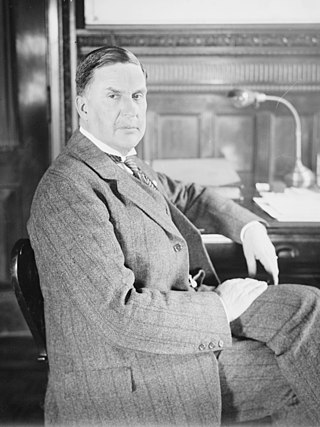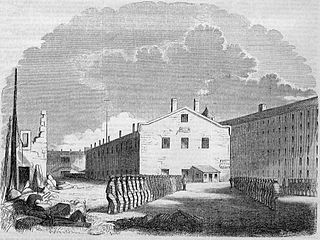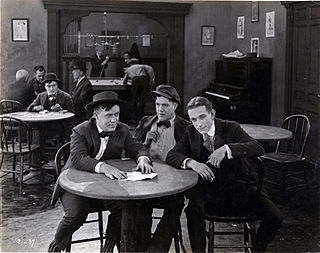
Penology is a subfield of criminology that deals with the philosophy and practice of various societies in their attempts to repress criminal activities, and satisfy public opinion via an appropriate treatment regime for persons convicted of criminal offences.

Prison Fellowship is the world's largest Christian nonprofit organization for prisoners, former prisoners, and their families, and a leading advocate for justice reform.

Sing Sing Correctional Facility, formerly Ossining Correctional Facility, is a maximum-security prison operated by the New York State Department of Corrections and Community Supervision in the village of Ossining, New York. It is about 30 miles (48 km) north of New York City on the east bank of the Hudson River. It holds about 1,700 inmates and housed the execution chamber for the State of New York until the abolition of capital punishment in New York in 1977.

Thomas Mott Osborne was an American prison officer, prison reformer, industrialist and New York State political reformer. In an assessment of Osborne's life, a New York Times book reviewer wrote: "His career as a penologist was short, but in the interval of the few years he served he succeeded in revolutionizing American prison reform, if not always in fact, then in awakening responsibility.... He was made of the spectacular stuff of martyrs, to many people perhaps ridiculous, but to those whose lives his theories most closely touched, inspiring and often godlike."

Recidivism is the act of a person repeating an undesirable behavior after they have experienced negative consequences of that behavior, or have been trained to extinguish it. Recidivism is also used to refer to the percentage of former prisoners who are rearrested for a similar offense.

Prison reform is the attempt to improve conditions inside prisons, improve the effectiveness of a penal system, or implement alternatives to incarceration. It also focuses on ensuring the reinstatement of those whose lives are impacted by crimes.
A reformatory or reformatory school is a youth detention center or an adult correctional facility popular during the late 19th and early 20th centuries in Western countries. In the United Kingdom and United States, they came out of social concerns about cities, poverty, immigration, and gender following industrialization, as well as from a shift in penology to reforming instead of punishing the criminal. They were traditionally single-sex institutions that relied on education, vocational training, and removal from the city. Although their use declined throughout the 20th century, their impact can be seen in practices like the United States' continued implementation of parole and the indeterminate sentence.
Auburn Correctional Facility is a state prison on State Street in Auburn, New York, United States. It was built on land that was once a Cayuga village. It is classified as a maximum security facility.

The Auburn system is a penal method of the 19th century in which persons worked during the day in groups and were kept in solitary confinement at night, with enforced silence at all times. The silent system evolved during the 1820s at Auburn Prison in Auburn, New York, as an alternative to and modification of the Pennsylvania system of solitary confinement, which it gradually replaced in the United States. Whigs favored this system because it promised to rehabilitate criminals by teaching them personal discipline and respect for work, property, and other people.

The warden or governor, also known as a superintendent or director, is the official who is in charge of a prison.

Incapacitation in the context of criminal sentencing philosophy is one of the functions of punishment. It involves capital punishment, sending an offender to prison, or possibly restricting their freedom in the community, to protect society and prevent that person from committing further crimes. Incarceration, as the primary mechanism for incapacitation, is also used as to try to deter future offending.

A prison, also known as a jail, gaol, penitentiary, detention center, correction center, correctional facility, or remand center, is a facility where people are confined against their will and denied a variety of freedoms under the authority of the state, generally as punishment for various crimes. Authorities most commonly use prisons within a criminal-justice system: people charged with crimes may be imprisoned until their trial; those who have pled or been found guilty of crimes at trial may be sentenced to a specified period of imprisonment.

A prisoner is a person who is deprived of liberty against their will. This can be by confinement or captivity in a prison, or forcible restraint. The term usually applies to one serving a sentence in prison.
The Wardens of Sing Sing are appointed by the Commissioner of the Department of Corrections and Community Supervision.

Imprisonment began to replace other forms of criminal punishment in the United States just before the American Revolution, though penal incarceration efforts had been ongoing in England since as early as the 1500s, and prisons in the form of dungeons and various detention facilities had existed as early as the first sovereign states. In colonial times, courts and magistrates would impose punishments including fines, forced labor, public restraint, flogging, maiming, and death, with sheriffs detaining some defendants awaiting trial. The use of confinement as a punishment in itself was originally seen as a more humane alternative to capital and corporal punishment, especially among Quakers in Pennsylvania. Prison building efforts in the United States came in three major waves. The first began during the Jacksonian Era and led to the widespread use of imprisonment and rehabilitative labor as the primary penalty for most crimes in nearly all states by the time of the American Civil War. The second began after the Civil War and gained momentum during the Progressive Era, bringing a number of new mechanisms—such as parole, probation, and indeterminate sentencing—into the mainstream of American penal practice. Finally, since the early 1970s, the United States has engaged in a historically unprecedented expansion of its imprisonment systems at both the federal and state level. Since 1973, the number of incarcerated persons in the United States has increased five-fold. Now, about 2,200,000 people, or 3.2 percent of the adult population, are imprisoned in the United States, and about 7,000,000 are under supervision of some form in the correctional system, including parole and probation. Periods of prison construction and reform produced major changes in the structure of prison systems and their missions, the responsibilities of federal and state agencies for administering and supervising them, as well as the legal and political status of prisoners themselves.

The Right Way is a 1921 American silent drama film distributed by Producers Security. It was directed by Sidney Olcott and starred Joseph Marquis and Edwards Davis. It was sponsored by Thomas Mott Osborne, former warden in Sing Sing prison and a leading advocate in America for prison reform and defender of the Mutual League.
Criminal justice reform seeks to address structural issues in criminal justice systems such as racial profiling, police brutality, overcriminalization, mass incarceration, and recidivism. Criminal justice reform can take place at any point where the criminal justice system intervenes in citizens’ lives, including lawmaking, policing, and sentencing.
Osborne Association is a non-governmental, multi-service, criminal justice reform, and direct service organization. Osborne runs programs for people who have been in conflict with the law and their families. It operates from community offices in Brooklyn, The Bronx, Buffalo, Manhattan, and Newburgh, New York, White Plains, New York, Troy, New York and inside more than forty New York State prisons and jails. They work with the families and communities of incarcerated individuals to try and redress harm done by the criminal justice system, whilst also working to reform the system by challenging racist policies and retributive justice.

Norway's criminal justice system focuses on the principles of restorative justice and the rehabilitation of prisoners. Correctional facilities in Norway focus on maintaining custody of the offender and attempting to make them functioning members of society. Norway's prison system is renowned as one of the most effective and humane in the world.

Victor Folke Nelson was a Swedish-American writer, prisoner, and prison reform advocate. He spent many years incarcerated in both the New York and Massachusetts prison systems and came to the attention of neurologist Abraham Myerson and penologist Thomas Mott Osborne for his potential as a writer. In 1932, Nelson published his book Prison Days and Nights with the assistance of Dr. Myerson.










